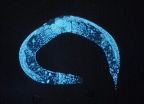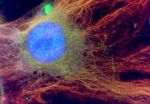(Press-News.org) This news release is available in French.
The scientific community agrees that autism has its origins in early life—foetal and/or postnatal. The team led by Yehezkel Ben-Ari, Inserm Emeritus Research Director at the Mediterranean Institute of Neurobiology (INMED), has made a breakthrough in the understanding of the disorder. In an article published in Science, the researchers demonstrate that chloride levels are elevated in the neurons of mice used in an animal model of autism, and remain at abnormal levels from birth. These results corroborate the success obtained with the diuretic treatment tested on autistic children by the researchers and clinicians in 2012, and suggest that administration of diuretics to mice before birth corrects the deficits in the offspring. They also show that oxytocin, the birth hormone, brings about a decrease in chloride level during birth, which controls the expression of the autistic syndrome.
This work is due to appear in the 7 February 2014 issue of Science.
Neurons contain high levels of chloride throughout the entire embryonic phase. As a result, GABA, the main chemical messenger of the brain, excites the neurons during this phase instead of inhibiting them, in order to facilitate construction of the brain. Subsequently, a natural reduction in chloride levels allows GABA to exercise its inhibitory role and regulate the activity of the adolescent/adult brain. In many brain disorders (childhood epilepsy, cranial trauma, etc.), studies have shown abnormally high chloride levels. Having made various observations, Dr Lemonnier's team (Brest), and Yehezkel Ben-Ari's team at Inserm carried out a clinical trial in 2012, based on the hypothesis of high chloride levels in the neurons of patients with autism. The researchers showed that administration of a diuretic to children with autism (which reduces neuronal chloride levels) has beneficial effects . The results of the trial supported this hypothesis, but because high neuronal chloride levels could not be demonstrated in children with autism, it was not possible to prove the mechanism proposed or justify the treatment.
In the present study, the researchers therefore used two animal models of autism, a genetic model, Fragile X syndrome, which is the genetic mutation most frequently associated with autism, and another, generated by injecting the pregnant mice with sodium valproate, a product known to generate abnormalities in children, including autistic spectrum disorder.
A high level of chloride in the brain
For the first time, the researchers recorded the activity of neurons at the embryonic stage and immediately after birth in order to observe modifications in chloride levels. These observations showed that neuronal chloride levels are abnormally high in both young and adult animals used in the autism model. GABA strongly excites neurons, and the researchers recorded aberrant electrical activities in the brain, which persist in adult animals.
The fall in chloride level, a particularly impressive phenomenon seen at birth in control animals, is absent in both of these animal models, and the neurons have the same chloride level before and after birth. These high levels are due to reduced activity of a chloride transporter, thus preventing transport of chloride out of the neuron. As a result, a major feature of neurons during birth is abolished in animal models of autism.
"Chloride levels during delivery are determinants of the occurrence of autism spectrum disorder," explains Yehezkel Ben-Ari, an Emeritus Research Director at Inserm.
Beneficial effects of the diuretic on brain activity
The researchers administered a diuretic treatment to the mother (in both animal models) for 24 hours shortly before delivery to see if this would restore brain inhibition in the offspring. They showed that the drop in chloride level was re-established in the neurons several weeks after a single treatment during birth. According to the research team, antenatal treatment restored brain activity to approximately normal levels, and corrected the "autistic" behaviour in the animals once they became adults.
"These results thus validate the working hypothesis that led us to the treatment we developed in 2012," states the principal author of the study.
Oxytocin, the birth hormone, naturally reduces chloride levels
The role of oxytocin in reducing neuronal chloride was also studied. The researchers had previously shown in 2006 that this hormone, which triggers labour, also has many beneficial actions on the brains of newborns, including protective effects in the event of complications during delivery, and even analgesic properties. Oxytocin acts like the diuretic, reducing the intracellular chloride levels.
In the present study, the team tested the long-term effects of blocking the actions of the hormone before birth. A drug that blocks the signals generated by oxytocin was injected into pregnant mice. The researchers evaluated the effects of this blockage on the offspring, and showed that it reproduced the entire autism-like syndrome in them, both with respect to the electrical and behavioural aspects (identical to the two animal models of autism). As a result, the hormone's natural actions, just like those of the diuretic, are crucial to this delicate phase, and may control the pathogenesis of autism via the cellular chloride levels.
"These data validate our treatment strategy, and suggest that oxytocin, by acting on the chloride levels during delivery modulates/controls the expression of autism spectrum disorder," states Yehezkel Ben-Ari.
Taken together, these observations suggest that earliest possible treatment is essential for maximum possible prevention of the disorder.
This work raises the importance of carrying out early epidemiological studies in order to better understand the pathogenesis of the disorder, especially through analysing data on deliveries where a drop in chloride has occurred. Indeed, complicated deliveries with episodes of prolonged lack of oxygen, for example, or complications during pregnancy, such as viral infections, are often suggested as risk factors.
Finally, given the role of oxytocin in triggering labour, "although it is true that epidemiological data suggesting that scheduled caesarean deliveries may have increased the incidence of autism are controversial, it nonetheless remains that these studies should be followed up and extended in order to confirm or refute this relationship, which is still possible," insists Yehezkel Ben-Ari, who concludes, "To treat this type of disorder, it is necessary to understand how the brain develops and how genetic mutations and environmental insults modulate brain activity in utero."
INFORMATION: END
Autism: Birth hormone may control the expression of the syndrome in animals
2014-02-06
ELSE PRESS RELEASES FROM THIS DATE:
Opening 'the X-files' helped researchers to understand why women and men differ in height
2014-02-06
Researchers from the University of Helsinki analyzed thoroughly the commonly occurring genetic variation in chromosome X, one of the two sex-determining chromosomes, in almost 25,000 Northern European individuals with diverse health-related information available. The aim of the study was to find genetic factors that could explain individual differences in several traits, including BMI, height, blood pressure and lipid levels. In addition, the researchers also investigated whether the X chromosome would contribute to some of the well-known differences between men and women ...
Theorists predict new forms of exotic insulating materials
2014-02-06
CAMBRIDGE, Mass-- Topological insulators — materials whose surfaces can freely conduct electrons even though their interiors are electrical insulators — have been of great interest to physicists in recent years because of unusual properties that may provide insights into quantum physics. But most analysis of such materials has had to rely on highly simplified models.
Now, a team of researchers at MIT has performed a more detailed analysis that hints at the existence of six new kinds of topological insulators. The work also predicts the materials' physical properties in ...
Researchers pinpoint protein associated with canine hereditary ataxia
2014-02-06
Researchers from North Carolina State University have found a link between a mutation in a gene called RAB 24 and an inherited neurodegenerative disease in Old English sheepdogs and Gordon setters. The findings may help further understanding of neurodegenerative diseases and identify new treatments for both canine and human sufferers.
Hereditary ataxias are an important group of inherited neurodegenerative diseases in people. This group of diseases is the third most common neurodegenerative movement disorder after Parkinson's and Huntington's diseases.
In people with ...
Nutritional supplement improves cognitive performance in older adults, study finds
2014-02-06
Tampa, FL (Feb. 6, 2014) – Declines in the underlying brain skills needed to think, remember and learn are normal in aging. In fact, this cognitive decline is a fact of life for most older Americans.
Therapies to improve the cognitive health of older adults are critically important for lessening declines in mental performance as people age. While physical activity and cognitive training are among the efforts aimed at preventing or delaying cognitive decline, dietary modifications and supplements have recently generated considerable interest.
Now a University of South ...
Immune system 'overdrive' in pregnant women puts male child at risk for brain disorders
2014-02-06
Johns Hopkins researchers report that fetal mice — especially males — show signs of brain damage that lasts into their adulthood when they are exposed in the womb to a maternal immune system kicked into high gear by a serious infection or other malady. The findings suggest that some neurologic diseases in humans could be similarly rooted in prenatal exposure to inflammatory immune responses.
In a report on the research published online last week in the journal Brain, Behavior and Immunity, the investigators say that the part of the brain responsible for memory and spatial ...
Source of chlamydia reinfections may be GI tract
2014-02-06
The current standard of care treatment for chlamydia sometimes fails to eradicate the disease, according to a review published ahead of print in Infection and Immunity, and the culprit may be in the gut.
Chlamydia trachomatis not only infects the reproductive tract, but abides persistently—though benignly—in the gastrointestinal tract. There it remains even after eradication from the genitals by the antibiotic, azithromycin, says first author Roger Rank, of the Arkansas Children's Research Institute, Little Rock. And that reservoir is likely a source of the all-too-common ...
Scientific review points to supplement users engaging in a pattern of healthy habits
2014-02-06
Washington, D.C., February 6, 2014—Dietary supplement users take these products as just one component of a larger effort to develop a healthier lifestyle, according to a newly published review in Nutrition Journal, a peer-reviewed scientific publication. The review, "Health Habits and Other Characteristics of Supplement Users" (Nutrition Journal.2014, 13:14), co-authored by Council for Responsible Nutrition (CRN) consultant Annette Dickinson, Ph.D., and CRN's senior vice president, scientific and regulatory affairs, Duffy MacKay, N.D., examined data from 20 peer-reviewed ...
Global regulator of mRNA editing found
2014-02-06
An international team of researchers, led by scientists from the University of California, San Diego School of Medicine and Indiana University, have identified a protein that broadly regulates how genetic information transcribed from DNA to messenger RNA (mRNA) is processed and ultimately translated into the myriad of proteins necessary for life.
The findings, published today in the journal Cell Reports, help explain how a relatively limited number of genes can provide versatile instructions for making thousands of different messenger RNAs and proteins used by cells in ...
Toxin from brain cells triggers neuron loss in human ALS model
2014-02-06
NEW YORK, NY (February 6, 2014) — In most cases of amyotrophic lateral sclerosis (ALS), or Lou Gehrig's disease, a toxin released by cells that normally nurture neurons in the brain and spinal cord can trigger loss of the nerve cells affected in the disease, Columbia researchers reported today in the online edition of the journal Neuron.
The toxin is produced by star-shaped cells called astrocytes and kills nearby motor neurons. In ALS, the death of motor neurons causes a loss of control over muscles required for movement, breathing, and swallowing. Paralysis and death ...
New insight into an emerging genome-editing tool
2014-02-06
The potential is there for bacteria and other microbes to be genetically engineered to perform a cornucopia of valuable goods and services, from the production of safer, more effective medicines and clean, green, sustainable fuels, to the clean-up and restoration of our air, water and land. Cells from eukaryotic organisms can also be modified for research or to fight disease. To achieve these and other worthy goals, the ability to precisely edit the instructions contained within a target's genome is a must. A powerful new tool for genome editing and gene regulation has ...




